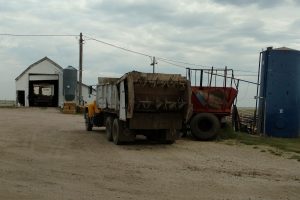by Joel DeRouchey, Extension Livestock Specialist
 With fall season approaching, many livestock producers will be applying solid manure to fields post-harvest. Manure from livestock producers, both large and small, is recognized as a valuable fertilizer source. However, it certainly involves needed equipment and labor often above that needed to apply commercial sources when considering the scraping, hauling, spreading and potential tillage incorporation into the soil. All sharp penciled livestock producers understand with the dramatic shift in fertilizer prices for nitrogen and phosphorus, the value of manure has never been higher and more economical to use as fertilizer. With overall input costs soaring, livestock producers must utilize their manure effectively in their cropping operations and or in merchandising the manure as a potential revenue stream.
With fall season approaching, many livestock producers will be applying solid manure to fields post-harvest. Manure from livestock producers, both large and small, is recognized as a valuable fertilizer source. However, it certainly involves needed equipment and labor often above that needed to apply commercial sources when considering the scraping, hauling, spreading and potential tillage incorporation into the soil. All sharp penciled livestock producers understand with the dramatic shift in fertilizer prices for nitrogen and phosphorus, the value of manure has never been higher and more economical to use as fertilizer. With overall input costs soaring, livestock producers must utilize their manure effectively in their cropping operations and or in merchandising the manure as a potential revenue stream.
Feedlot manure will generally contain between 15 to 20 lbs/ton of both nitrogen and phosphate (P2O5). The nutrient profile can be influenced by many factors, including dietary nutrient levels, frequency of manure scraping, and length of stockpiling before spreading. As the diet fed increases in nutrient content above the animal’s requirement, the excess is simply excreted. There are circumstances where it is more economical to fed excessive levels of nutrients. One instance is the use of by-products, where increasing their use lowers cost per lb of gain, this also leads to overfeeding nutrients and increasing the levels of nutrient excretion. When lots are cleaned frequently, the nitrogen on the pen surface is captured at a higher rate. Since some nitrogen is volatile in manure, the longer it stays on the pen surface, the larger losses of nitrogen one can expect. Typically 50% of the nitrogen excreted is lost to volatilization before it is scraped and land applied. Also, for operations that scrape and stockpile manure for spreading at a later time, the nitrogen in the stockpiles will begin to breakdown over several months of storage. This is due to a compost type effect where microbes use the nitrogen as an energy source. However, since P2O5 is not volatile or reduced by composting, its levels are generally unchanged compared to the amount that is actually excreted.
To obtain maximum fertilizer value of manure, proper nutrient crediting and timing of application incorporation is needed. While all of this may seem complicated to those thinking about utilizing manure, in fact they are all very manageable. When relating to these issues, once again the nitrogen portion of manure is the most sensitive. Nitrogen in manure is in two forms, inorganic and organic. In the case of scraped beef feed lot manure, about 35% is in inorganic while 65% is in an organic form. The inorganic portion, otherwise known as ammonium nitrogen, is readily available for crop use. This is also the type of nitrogen that is volatile and lost from the pen or field surface. Secondly, manure contains organic nitrogen, which needs to undergo mineralization to be available for crop use. Typically, 25% of the organic nitrogen will mineralize for the next crop utilization, with 12% mineralized for year 2 and 6% for year 3. Thus, producers need to be aware of the nitrogen crediting that they can do to reduce cost on future years to fully utilize the nitrogen in manure that is applied. Finally, when solid manure is field applied, the impact of crop available nitrogen is directly related to the timing of incorporation into the soil. If manure is incorporated within 1 day of spreading, approximately 90% of the inorganic nitrogen will be retained. However, if incorporation does not occur for 7 days or longer, or in the case of no-till is solely surface applied, only about 5% will remain for crop use. In the case of P2O5, all will be retained for use regardless of application timing and incorporation. Also, it is generally viewed that 100% of the P2O5 in manure is available for crop use.
Producers need to properly distribute nutrients not to build excessive amount of P2O5. Historically, most producers have spread solid manure to meet the nitrogen requirement for the upcoming crop, but this also spreads enough P2O5 for multiple years. With many operations now implementing nutrient management plans, the basis of application is on a P2O5 removal rate based on crops planted. While hauling manure longer distances was not previously economically justifiable in many cases, producers need to reevaluate their nutrient distribution based on current fertilizer prices.
Kansas State University publication MF-2562 “Estimating Manure Nutrient Availability” describes in further detail about nutrient availability, crediting, and general guidelines for using manure.
In addition, information on all aspects of manure management can be assessed through the national eXtension Animal Manure Management website that provides information from land grant universities across the United States at: extension.org/animal_manure_management